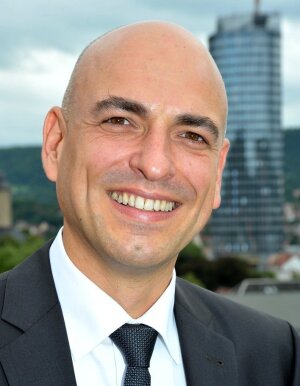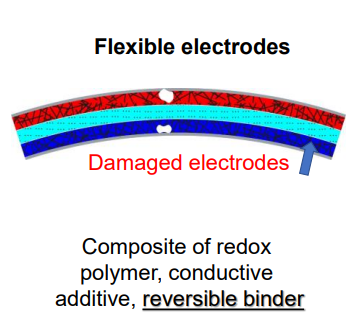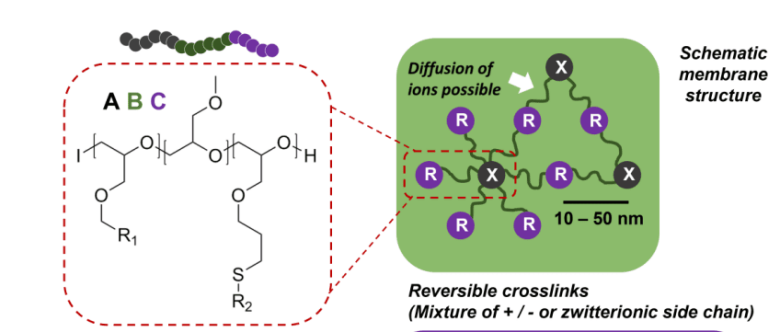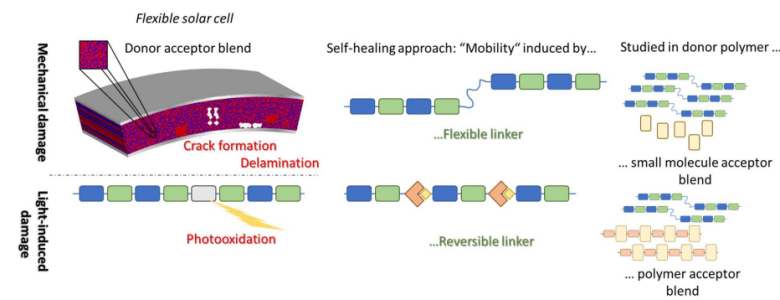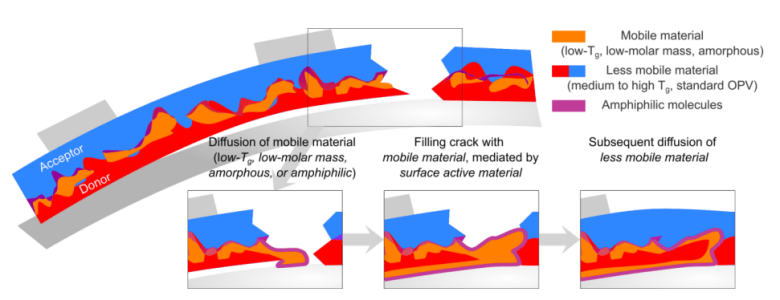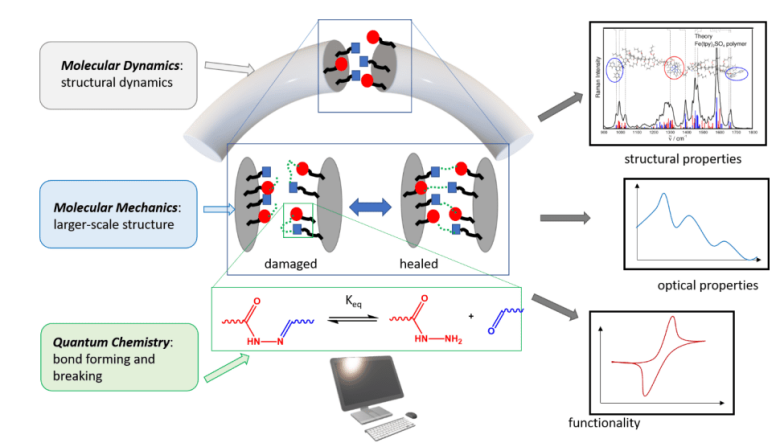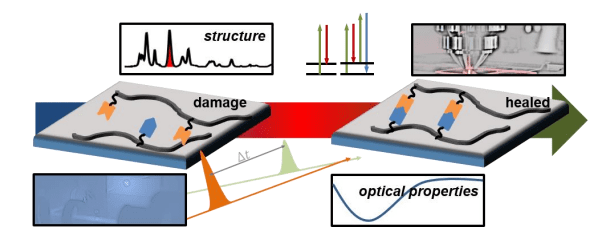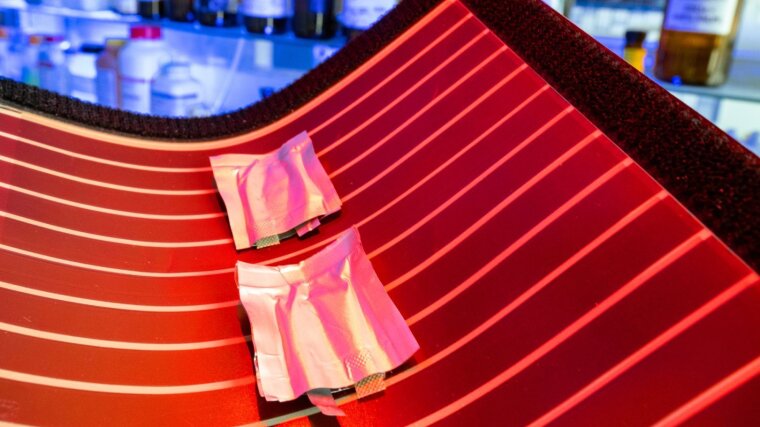
The research unit FOR 5301 is dedicated to the design, synthesis and detailed characterization of self-healing materials for flexible energy storage and conversion ( e.g., supercapacitors, polymer-based batteries and solar cells). With this, FOR goes far beyond the status of “classic” self-healing materials. The focus here is no longer just on restoring polymer coatings after mechanical damage (healing of cracks). Instead, functions and properties in complex material systems are to be cured, e.g. optical properties of conjugated polymers or conductivity in electrodes or electrolytes.
PI's are Prof. Dr. Andrea Balducci, Prof. Dr. Benjamin Dietzek-Ivanšić, Prof. Dr. Stefanie Gräfe, Dr. Martin D. Hager, PD Dr. Harald Hoppe, Prof. Dr. Kalina Peneva, Prof. Dr. Jürgen Popp, Prof. Dr. Felix H. Schacher and Prof. Dr. Ulrich S. Schubert from the Friedrich Schiller University Jena as well as PD Dr. Martin Presselt from the Leibniz Institute of Photonic Technology.
Spokesperson of the Research Unit
Prof. Dr. Ulrich S. Schubert
Image: Anne Günther (University of Jena)Prof. Dr. Ulrich S. Schubert
Friedrich Schiller University Jena
Laboratory of Organic and Macromolecular Chemistry
Humboldtstr. 10
07743 Jena
ulrich.schubert@uni-jena.de
Phone: +49 3641 9-48201
Fax: +49 3641 9-48202
Projects
As part of FOR 5301, six scientific and one start-up projects deal with self-healing materials for electrochemical energy storage and converters:
-
P1 - Self-healing electrodes for electro(chemical) energy storage
Principle Investigators
Prof. Dr. Ulrich S. Schubert
Friedrich Schiller University Jena
Laboratory of Organic and Macromolecular Chemistry
Humboldtstr. 10
07743 Jena
ulrich.schubert@uni-jena.de
Phone: +49 3641 9-48201
Fax: +49 3641 9-48202Prof. Dr. Andrea Balducci
Friedrich Schiller University Jena
Institute of Technical and Environmental Chemistry
Philosophenweg 7a
07743 Jena
andrea.balducci@uni-jena.de
Phone: +49 3641 9-48464
Fax: +49 3641 9-48402Project Outline
The self-healing of polymers has been studied intensively in recent years. In doing so, general design principles could be established enabling the preparation of healable polymers. As part of the project, these concepts are now to be transferred to functional materials. Specifically, new types of electrodes for use in organic radical batteries or (super)capacitors are to be developed, which are characterized by their ability to heal themselves.
For this purpose, self-healing polymers with various reversible groups are integrated into the electrode materials in order to ultimately enable cracks and damage to be healed. In addition to the synthesis, a focus will be on the characterization of the materials and, in particular, on the investigation of the self-healing properties. On the one hand, the cracks in the electrodes will be examined optically and tactilely, on the other hand, the restoration of functional properties, such as conductivity or capacity, will be analyzed. In particular, a new method will be established with which the healing of functional materials can be quantified in detail. Finally, the project aims to design new self-healing electrodes for applications in organic radical batteries and supercapacitors and to elucidate structure-property relationships for self-healing functional materials.
Grafik P01
Graphic: Prof. Dr. Andrea Balducci, Prof. Dr. Ulrich S. Schubert / Universität Jena -
P2 - Nanostructured block copolymer gel electrolytes based on polyethers
Principle Investigator
Prof. Dr. Felix Helmut Schacher
Friedrich Schiller University Jena
Laboratory of Organic and Macromolecular Chemistry
Jena Center of Soft Matter
Lessingstr. 8
07743 Jena
felix.schacher@uni-jena.de
Phone: +49 3641 9-48250
Fax: +49 3641 9-48252Project Outline
The goal of project 2 is to design nanostructured block copolymer gels for use as electrolytes in polymer-based batteries and electric double-layer capacitors.
These materials also feature self-healing properties, whereby the designed nanostructure additionally enables the restoration of the functional properties after mechanical damage. For this purpose, amphiphilic polyether-based ABC triblock terpolymers will be utilized with a (covalently) crosslinkable block A (furfuryl moieties for Diels-Alder reactions or alkynes for copper-catalyzed azide-alkyne chemistry), a block B being soluble in both organic and aqueous electrolytes providing ion mobility (e.g., poly(methyl glycidyl ether)), and a block C carrying charged repeating units for reversible (non-covalent) crosslinks based on combinations of carboxyl and amino moieties or alternatively, zwitterionic comonomers. The synthesis will be accomplished using a combination of sequential living anionic polymerization of the respective glycidyl ether monomers (i.e. furfuryl or alkynyl glycidyl ether for block A, e.g., methyl glycidyl ether for block B, allyl glycidyl ether ether for block C) followed by side chain modification of the C block using thiol-ene click chemistry to realize the charged repeating units.
The characterization will play an important role in this project starting from the comprehensive analysis of the ABC triblock terpolymers towards the preparation of the respective gels, including investigations of crosslinking efficiencies and probing the stability besides morphological studies. Furthermore, the functionality, i.e. the ionic conductivity, of the gels should be precisely understood with regard to the diffusion of ions, to evaluate the self-healing progress in the end. Finally, the gel electrolytes will be used in test batteries as proof-of-principle for new electrolyte materials.
Grafik P02
Graphic: Prof. Dr. Felix H. Schacher / Universität Jena -
P3 - Reversible photoactive materials for flexible bulk-heterojunction solar cells
Principle Investigators
Prof. Dr. Kalina Peneva
Friedrich Schiller University Jena
Laboratory of Organic and Macromolecular Chemistry
Jena Center of Soft Matter
Lessingstr. 8
07743 Jena
kalina.peneva@uni-jena.de
Phone: +49 3641 9-48790
Fax: +49 3641 9-48792Dr. Martin Hager
Friedrich Schiller University Jena
Laboratory of Organic and Macromolecular Chemistry
Humboldtstr. 10
07743 Jena
martin.hager@uni-jena.de
Phone: +49 3641 9-48227
Fax: +49 3641 9-48202Project Outline
Organic solar cells have been studied intensively in recent years and the achievable efficiencies have been significantly increased. However, the long-term stability of these systems is still often a challenge. In addition to the photo-oxidation of the active materials, e.g., conjugated polymers, cracks in the active material or delamination of the active layer from the electrodes also play a major role, in particular for flexible solar cells. In this context, this project of the research unit FuncHeal investigates new concepts for self-healing of photoactive materials that are suitable for organic solar cells.
Two damage scenarios will be investigated: i) Mechanical damage in the active layer (donor-acceptor blend) and ii) damage through photooxidation. Through the design and synthesis of tailor-made donor and acceptor materials (from small molecules to polymers), the introduction of flexible groups or reversible groups is intended to achieve mobility of the material on the one hand (healing of cracks) and on the other hand the introduction of reversible groups to enable the exchange of chromophores (healing after photooxidation). These processes will be examined in detail in the pure donor materials as well as in the blend with appropriately adapted acceptor materials.
Grafik P03
Graphic: Prof. Dr. Kalina Peneva, Dr. Martin D. Hager / Universität Jena -
P4 - Stress and strain resisting polymer solar cells: Towards high flexibility
Principle Investigators
PD Dr. Harald Hoppe
Friedrich Schiller University Jena
Laboratory of Organic and Macromolecular Chemistry
Humboldtstr. 10
07743 Jena
harald.hoppe@uni-jena.de
Phone: +49 3641 9-48995
Fax: +49 3641 9-48202PD Dr. Martin Presselt
Leibniz Institute of Photonic Technology
Albert-Einstein-Str. 9
07745 Jena
martin.presselt@leibniz-ipht.de
Phone: +49 3641 206-418Project Outline
The stability of polymer solar cells, in which at least one component of the photoactive layer is a conjugated polymer, is often studied as a function of the illumination spectrum, temperature (cycles), humidity, and influence of reactants such as oxygen or water. In addition, attention is paid to long-term stable mixing of electron donors and acceptors, which is referred to the morphological stability.
In particular for potential real applications, the flexible properties of organic solar modules are important, which, however, places increased demands on their mechanical stability. Due to the bending of solar modules that occurs during application, cracks in the active layer as well as detachment of the active layer from the charge extraction layers (or electrodes) can occur. The latter process is called delamination and it occurs when the adhesion between two layers is unsatisfactory, while cracks within a layer indicate insufficient cohesion. P4 is, therefore, dedicated to the prevention of cracks and delamination defects, as well as to their healing. The material systems are based on the donor / acceptor materials provided by a different project or on classical poly(3-alkylthiophenes) in combination with fullerene derivatives and later also non-fullerene acceptors. The photoactive layer also consists of at least ternary mixtures to be able to map the required properties. To investigate healing, films and solar cells on flexible substrates are stretched or bent, respectively, to provoke cracking and delamination. The defects created by the mechanical stress are characterized and quantified by microscopic and spectroscopic methods. After the healing, an analogous procedure is performed enabling a quantification of the healing.
Grafik P04
Graphic: PD. Dr. Harald Hoppe, PD Dr. Martin Presselt / Universität Jena -
P5 - Computational modeling of degradation and recovery processes of self-healing functional materials
Principle Investigator
Prof. Dr. Stefanie Gräfe
Friedrich Schiller University Jena
Institute of Physical Chemistry
Helmholtzweg 4
07743 Jena
s.graefe@uni-jena.de
Phone: +49 3641 9-48330
Fax: +49 3641 9-48302Project Outline
Self-healing materials are very interesting for many applications due to their ability to repair structural damage and, thus, to regain their mechanical stability and properties. For self-healing functional materials, in addition to the structural repair, ideally the functionality should also be recovered. The design of such materials is very challenging and can benefit from computational studies of the self-healing process and of the functionality down to the molecular level.
In this context, a large toolset of theoretical and simulation methods will be applied in this project to understand the degradation and recovery of various self-healing functional materials. The employed methods cover a range of relevant spatial and temporal scales: From larger-scale dynamical processes and structural properties (molecular dynamics and molecular mechanics calculations) to the molecular level (quantum chemical and hybrid quantum chemical-molecular mechanical calculations). The systems of investigation are chosen in close collaboration with the experimental projects of this research unit.
The overall objective of the project is the modelling and exploring the underlying mechanisms leading to degradation, thereby aiding the synthesis-oriented projects in identifying possibilities either to avoid degradation or to regenerate the material and the functionality. In particular, spectroscopic observables will be simulated such as UV/vis, Raman or 2D-correlation spectra which are used in the experimental investigations of self-healing processes. Eventually, general structure-property relationships will be revealed for functional self-healing materials which can help aiding the design of those materials.
Grafik P05
Graphic: Prof. Dr. Stefanie Gräfe / Universität Jena -
P6 - Optical (micro)spectroscopy for characterizing structure and electronic properties of self-healing materials for energy conversion and storage
Principle Investigators
Prof. Dr. Benjamin Dietzek-Ivanšić
Friedrich Schiller University Jena
Institute of Physical Chemistry
Helmholtzweg 4
07743 Jena
benjamin.dietzek@uni-jena.de
Phone: +49 3641 9-48360
Fax: +49 3641 9-48302Prof. Dr. Jürgen Popp
Institute for Physical Chemistry (IPC)
Friedrich Schiller Unviversity of Jena
Helmholtzweg 4
07743 Jena
juergen.popp@uni-jena.de
Phone: +49 3641 9-48320Project Outline
Project 6 will characterize the molecular mechanism in self-healing materials for energy conversion and storage by means of multimodal frequency- and time-resolved optical spectroscopy. The experiments will provide insights into the complete lifecycle of a functional self-healing material from damage to healing. In doing so, the project will gain a detailed understanding of the molecular processes occurring during healing of functional materials For polymer-based batteries and supercapacitors as well as organic solar cells.
To this end, the project’s focus is threefold:
- Investigation of the molecular structure changes during degradation and self-healing via in-situ vibrational spectroscopy and vibrational spectroelectrochemistry in combination with 2D correlation analysis to derive structureproperty relationships with respect to the underlying reversible self-healing chemistry;
- Studying transport and chemical reactivity to provide a molecular view on the diffusion and thus self-healing processes of the self-healing functional materials researched within FuncHeal, by combining fluorescence and non-linear Raman microscopy. Here, the molecular view will be correlated with macroscopic healing studies to enable tuning the molecular components inside the materials to achieve the desired macroscopic properties and
- Characterizing excited-state processes in damaged and healed materials for energy conversion to validate the light-induced function-determining process in self-healing materials for polymer solar cells. Furthermore, the project strives towards utilizing the spectroscopic signature of optically excited polymer materials to generate metrics to follow the kinetics of material degradation and healing.
Grafik P06
Graphic: Prof. Dr. Benjamin Dietzek-Ivanšić, Prof. Dr. Jürgen Popp -
Start-up funding - Self-healing electrolytes for flexible Zn-air batteries based on carbon fiber cathodes
Principle Investigators
Dr. Desirée Leistenschneider
Friedrich Schiller University Jena
Institute of Technical and Environmental Chemistry
Philosophenweg 7a
07743 Jena
desiree.leistenschneider@uni-jena.de
Phone: +49 3641 9-48432Project Outline
As part of the project, cathodes based on carbon fibers are to be developed for the application in flexible zinc-air batteries. These fibers will then be functionalized with various compounds. In order to achieve self-healing batteries, different electrolytes will be investigated, including blockcopolymer electrolytes from project P2. It will further be studied how the different electrolytes influence the performance of the battery and whether the effect of self-healing enables long-term use of these.
Publications
-
2025
W. T. Schulze, S. Schwalbe, K. Trepte, S. Gräfe
eminus - Pythonic electronic structure theoryExternal link
Software X 2025, 29, 102035, DOI: 10.1016/j.softx.2025.102035.M. Klein, P. Fesser, S. Zechel, M. D. Hager, U. S. Schubert
Self-healing behavior of metallopolymers in complex 3D-structures obtained by DLP-based 3D-printingExternal link
Chem. Eur. J. 2025, 31, e202404267, DOI: 10.1002/chem.202404267.M. Melchiorre, K. S. Teoh, J. L. Gomez Urbano, F. Ruffo, A. Balducci
A lactic acid dioxolane as a bio-based solvent for lithium-ion batteries: physicochemical and electrochemical investigations of lithium imide-based electrolytesExternal link
Green Chem. 2025, 27, 5040-5050, DOI: 10.1039/D4GC05476H.K. S. Teoh, M. Melchiorre, S. D. Magar, C. Leibing, F. Ruffo, J. L. Gomez Urbano, A. Balducci
Formulation and recycling of a novel electrolyte based on bio-derived γ-valerolactone and lithium bis(trifluoromethanesulfonyl)imide for lithium-ion batteriesExternal link
Small 2025, 21, 2407850, DOI: 10.1002/smll.202407850.S. J. Finkelmeyer, M. Presselt
Tuning optical properties of organic thin films through intermolecular interactions - Fundamentals, advances and strategiesExternal link
Chem. Eur. J. 2025, 31, e202403500, DOI: 10.1002/chem.202403500K. S. Teoh, W. T. Schulze, Z. Song, A. Croy, J. L. Gomez Urbano, S. Gräfe, A. Balducci
Investigation into the properties of γ-valerolactone and γ-butyrolactone imide-based electrolytes for lithium-ion batteriesExternal link
Battery Energy 2025, e70051, DOI: 10.1002/bte2.20250034.M. Orbay, K. S. Teoh, M. Melchiorre, C. Neumann, F. Ruffo, A. Turchanin, A. Balducci, J. L. Gomez Urbano
Itaconic anhydride as a novel bio-derived solid electrolyte interphase forming additive for lithium-ion batteriesExternal link
ChemSusChem 2025, 18, e202501134, DOI: 10.1002/cssc.202501134. -
2024
E. J. Askins, A. Sarkar, P. Navabi, K. Kumar, S. J. Finkelmeyer, M. Presselt, J. Cabana, K. D. Glusac
Interfacial electrochemistry of catalyst-coordinated graphene nanoribbonsExternal link
J. Am. Chem. Soc. 2024, 146, 22360–22373S. Schwalbe, W. T. Schulze, K. Trepte, S. Lehtola
Ensemble generalization of the Perdew–Zunger self-interaction correction: A way out of multiple minima and symmetry breakingExternal link
J. Chem. Theory Comput. 2024, 20, 7144–7154D. S. Pietruschka, A. Zaichenko, M. Richter, S. Gräfe, D. Mollenhauer
From lithium and sodium superoxides to singlet-oxygen – insights into the mechanism of dissociation using SHARC-MDExternal link
ChemPhysChem 2024, 25, e202400216.Y. T. Gerase, J. Garcia Lopez, J. Prince Madalaimuthu, A. Elmanova, S. Jasmin Finkelmeyer, A. Dellith, D. Blaschke, H. Schmidt, K. Peneva, H. Hoppe, M. Presselt
Long-term stable organic solar cells through amphiphilic additivesExternal link
ACS Appl. Electron. Mater. 2024, 6, 2258-2267.K. S. Teoh, M. Melchiorre, S. D. Magar, M. Hermesdorf, D. Leistenschneider, M. Oschatz, F. Ruffo, J. L. Gómez Urbano, A. Balducci
Fluorine-free lithium-ion capacitor with enhanced sustainability and safety based on bio-based ƴ-valerolactone and lithium bis(oxalato)borate electrolyteExternal link
Adv. Mater. 2024, 36, 2310056. -
2023
J. Hniopek, J. Meurer, S. Zechel, M. Schmitt, M. D. Hager, J. Popp
Molecular in situ monitoring of the pH-triggered response in adaptive polymers by two-dimensional Raman micro-correlation-spectroscopyExternal link
Chem. Sci. 2023, 14, 7248-7255.
F. Shohraty, J. Hniopek, J. Meurer, S. Zechel, M. Schmitt, J. Popp, M. D. Hager Thiol-ene reaction as reversible covalent bond for the design of shape-memory polymersExternal link
Macromol. Mater. Eng. 2023, 2300002.
K. S. Teoh, M. Melchiorre, F. A. Kreth, A. Bothe, L. Köps, F. Ruffo, A. Balducci
γ-Valerolactone as sustainable and low-toxic solvent for electrical double layer capacitorsExternal link
ChemSusChem 2023, 16, e202201845.
W. T. Schulze, S. Schwalbe, K. Trepte, A. Croy, J. Kortus, S. Gräfe
Bond formation insights into the Diels–Alder reaction: A bond perception and self-interaction perspectiveExternal link
J. Chem. Phys. 2023, 158, 164102. -
2022
J. Meurer, T. Bätz, J. Hniopek, C. Bernt, S. Zechel, M. Schmitt, J. Popp, M. D. Hager, U. S. Schubert
Application of orthogonal metal–ligand interactions for the synthesis of interpenetrating metallopolymer networks featuring shape-memory and self-healing abilitiesExternal link
J. Mater. Chem. A 2022, 10, 25106-25117.
